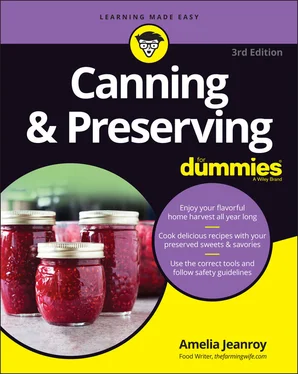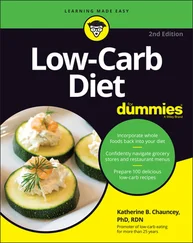 The pH, or potential of hydrogen, is the measure of acidity or alkalinity in food. The values range from 1 to 14. Neutral is 7. Lower values are more acidic, while higher values are more alkaline. The lower the pH value in your food, the more acidic it is.
The pH, or potential of hydrogen, is the measure of acidity or alkalinity in food. The values range from 1 to 14. Neutral is 7. Lower values are more acidic, while higher values are more alkaline. The lower the pH value in your food, the more acidic it is.
Adjusting for Your Altitude
Properly processing your home-canned foods destroys microorganisms. Knowing your altitude is important because the boiling point of water and pressure in a pressure canner changes at altitudes over 1,000 feet above sea level. This occurs because the air is thinner at higher elevations. With less air resistance, water boils at a temperature below 212 degrees.
To produce food free from microorganisms at higher elevations, adjust your processing time and pressure to compensate for your altitude. Use the altitude adjustment charts in Chapter 4(for water-bath canning) and in Chapter 9(for pressure canning). These adjustments ensure that your food is heated to the correct temperature for destroying microorganisms.
 If you don’t know the elevation of your town or city, check with your municipal offices, your public library, or your state or county cooperative extension office. Or go to
If you don’t know the elevation of your town or city, check with your municipal offices, your public library, or your state or county cooperative extension office. Or go to www.whatismyelevation.com and simply type in your Zip code.
Spoiler Alert: Identifying Food Spoilage
Food spoilage is the unwanted deterioration in canned or preserved food that makes your food unsafe for eating. Ingesting spoiled food causes a wide range of ailments, depending on the type of spoilage and the amount of food consumed. Symptoms vary from mild, flu-like aches and pains to more-serious illnesses or even death.
But having said that, the potential for spoiled food shouldn’t stop you from canning. When you understand the workings of these microscopic organisms and enzymes, you’ll know why using the correct processing method for the correct amount of time destroys these potentially dangerous food spoilers. And you’ll have nothing to worry about.
Mold, yeast, bacteria, and enzymes are the four spoilers. Microorganisms (mold, yeast, and bacteria) are independent organisms of microscopic size. Enzymes are proteins that exist in plants and animals. When one or more of these spoilers have a suitable environment, they grow rapidly and divide or reproduce every 10 to 30 minutes! With this high-speed development, it’s obvious how quickly food can spoil. Some of these create spoilage that can’t be seen with the naked eye (like botulism), while others (like mold) make their presence known visually.
 Living microorganisms are all around — in your home, in the soil, and even in the air you breathe. Sometimes microorganisms are added to food to achieve a fermented product, like beer or bread (for leavening). They’re also important for making antibiotics. The point? Not all microorganisms are bad, just the ones that cause disease and food spoilage.
Living microorganisms are all around — in your home, in the soil, and even in the air you breathe. Sometimes microorganisms are added to food to achieve a fermented product, like beer or bread (for leavening). They’re also important for making antibiotics. The point? Not all microorganisms are bad, just the ones that cause disease and food spoilage.
Mold is a fungus with dry spores. Poorly sealed jars of high-acid or pickled foods are perfect locations for these spores to set up housekeeping. After the spores float through the air and settle on one of their favorite foods, they start growing. At first you see what looks like silken threads, then streaks of color, and finally fuzz, which covers the food. Processing high-acid and pickled food in a water-bath canner destroys mold spores.
 Don’t eat food that’s had fuzz scraped off of it. This was thought safe at one time but not anymore. Mold contains carcinogens that filter into the remaining food. Although the food appears to be noninfected, ingesting this food can cause illness.
Don’t eat food that’s had fuzz scraped off of it. This was thought safe at one time but not anymore. Mold contains carcinogens that filter into the remaining food. Although the food appears to be noninfected, ingesting this food can cause illness.
Yeast spores are much less colorful, and grow in food in the same way as mold spores. They’re particularly fond of high-acid food that contains lots of sugar, like jam or jelly. They grow as a dry film on the surface of your food, more commonly inside the food, creating an off flavor and fermentation. Prevent yeast spores from fermenting in your food by destroying them in a water-bath canner.
Bacteria are a large group of single-celled microorganisms. Common bacteria are staphylococcus and salmonella. Botulism, the one to be most concerned with in canning, is the most dangerous form of bacteria and can be deadly. It’s almost undetectable because it’s odorless and colorless. Botulism spores are deadly but can be easily destroyed by heating the food to an internal temperature of 180 degrees Fahrenheit (85 degrees Celsius) for at least 5 minutes. Boiling occurs at 212 degrees Fahrenheit (100 degrees Celsius) and is the safest and easiest way to protect yourself from becoming ill.
Botulism spores hate high-acid and pickled foods, but they love low-acid foods. When you provide these spores with an airless environment containing low-acid food, like a jar of green beans, the spores produce a toxin in the food that can kill anyone who eats it. The only way to destroy them in low-acid food is by pressure canning.
 For safety’s sake, before eating any home-canned, low-acid food, boil it for 15 minutes from the point of boiling, if you are at an altitude of 1,000 feet or lower. For altitudes above 1,000 feet, add 1 additional minute for each 1,000 feet of elevation.
For safety’s sake, before eating any home-canned, low-acid food, boil it for 15 minutes from the point of boiling, if you are at an altitude of 1,000 feet or lower. For altitudes above 1,000 feet, add 1 additional minute for each 1,000 feet of elevation.
 Boiling kills the botulism bacteria, but only if boiled until the food reaches an internal temperature of 180 degrees Fahrenheit for at least 5 minutes. Symptoms from ingesting botulism-infected food occur within 12 to 36 hours after eating it. These symptoms include double vision and difficulty swallowing, breathing, and speaking. Seek medical attention immediately if you believe you’ve eaten infected food. Antitoxins are available to treat this poisoning, but the sooner, the better.
Boiling kills the botulism bacteria, but only if boiled until the food reaches an internal temperature of 180 degrees Fahrenheit for at least 5 minutes. Symptoms from ingesting botulism-infected food occur within 12 to 36 hours after eating it. These symptoms include double vision and difficulty swallowing, breathing, and speaking. Seek medical attention immediately if you believe you’ve eaten infected food. Antitoxins are available to treat this poisoning, but the sooner, the better.
No matter how long you boil your jars, they will never reach a higher temperature than that of boiling water. This is why water-bath canning and pressure canning are not interchangeable.
Enzymes are proteins that occur naturally in plants and animals. They encourage growth and ripening in food, which affects the flavor, color, texture, and nutritional value. Enzymes are more active at temperatures of 85 to 120 degrees Fahrenheit than they are at colder temperatures. They’re not harmful, but they can make your food overripe and unattractive, while opening the door for other microorganisms.
An example of enzymes in action occurs when you cut or peel an apple. After a few minutes, the apple starts to brown. Stop this browning by treating the cut apple with an antioxidant solution (see Chapter 5). Other methods for halting the enzymatic action in your food are blanching (see Chapter 15) and hot packing (see Chapter 5).
Читать дальше

 The pH, or potential of hydrogen, is the measure of acidity or alkalinity in food. The values range from 1 to 14. Neutral is 7. Lower values are more acidic, while higher values are more alkaline. The lower the pH value in your food, the more acidic it is.
The pH, or potential of hydrogen, is the measure of acidity or alkalinity in food. The values range from 1 to 14. Neutral is 7. Lower values are more acidic, while higher values are more alkaline. The lower the pH value in your food, the more acidic it is. If you don’t know the elevation of your town or city, check with your municipal offices, your public library, or your state or county cooperative extension office. Or go to
If you don’t know the elevation of your town or city, check with your municipal offices, your public library, or your state or county cooperative extension office. Or go to  Don’t eat food that’s had fuzz scraped off of it. This was thought safe at one time but not anymore. Mold contains carcinogens that filter into the remaining food. Although the food appears to be noninfected, ingesting this food can cause illness.
Don’t eat food that’s had fuzz scraped off of it. This was thought safe at one time but not anymore. Mold contains carcinogens that filter into the remaining food. Although the food appears to be noninfected, ingesting this food can cause illness. For safety’s sake, before eating any home-canned, low-acid food, boil it for 15 minutes from the point of boiling, if you are at an altitude of 1,000 feet or lower. For altitudes above 1,000 feet, add 1 additional minute for each 1,000 feet of elevation.
For safety’s sake, before eating any home-canned, low-acid food, boil it for 15 minutes from the point of boiling, if you are at an altitude of 1,000 feet or lower. For altitudes above 1,000 feet, add 1 additional minute for each 1,000 feet of elevation.










